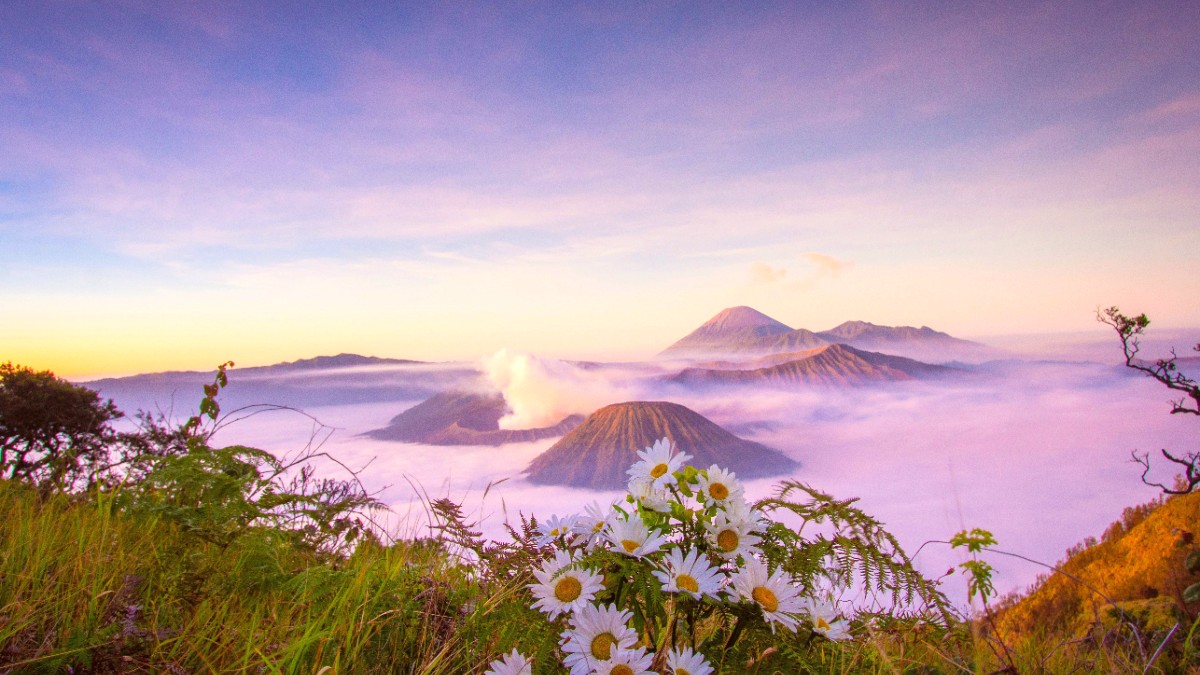
Indonesia
Mount Bromo is an active volcano and a central feature of the Bromo Tengger Semeru National Park. It is world-renowned for its spectacular sunrise views over a vast caldera, with the towering Mount Semeru frequently erupting in the background. Visitors typically take a pre-dawn jeep tour to a viewpoint, then trek across the "Sea of Sand" to reach the crater rim of Bromo.
Ijen Crater is famous for its unique blue flames, visible only at night, caused by ignited sulfuric gas. Its turquoise acid lake within the crater is the world's largest.
For detailed tour bookings to these attractions, visit GetYourGuide.com.
Archaeological park, site of ancient capital of Majapahit Empire. Explore ruins of temples and the Museum Majapahit.
A 13th-century Hindu-Buddhist temple from the Singhasari kingdom, outstanding for its unique tiered structure.
Remains of a large 13th-century Hindu temple complex directly associated with the Singhasari Kingdom.
A beautiful mosque with unique Chinese architectural influences, honoring Admiral Zheng He.
Walk through Surabaya's colonial-era buildings, ideal for walking tours and photography.
East Java's natural beauty extends beyond its famous volcanoes. From towering peaks to serene beaches, the region has diverse landscapes awaiting exploration.
Java's highest volcano and one of Indonesia's most active, Mount Semeru has a challenging multi-day trek suitable only for experienced hikers.
A highland resort town near Malang, known for its cool climate, fresh air, and extensive apple orchards. It also features various family-friendly theme parks.
A majestic waterfall hidden in a deep, circular canyon, Madakaripura Waterfall has a breathtaking experience. It is accessible via a trek.
Often called "Africa van Java," Baluran National Park has vast savanna landscapes. It is home to diverse wildlife, including deer, wild buffalo, and various bird species.
This park protects lush rainforest and coastline. It is home to the critically endangered Javan leopard. Sukamade Beach within the park is famous as a turtle nesting ground.
East Java's southern coast has numerous scenic beaches, including Teluk Hijau (Green Bay) and Pulau Merah (Red Island Beach).
A secluded beach with striking green-hued waters within Meru Betiri National Park. It some effort to reach.
Popular for surfing lessons, especially for beginners. It features reddish sand, especially noticeable at sunset.
A scenic white-sand beach with unique rock formations jutting out from the sea.
Discover lesser-known but equally captivating spots in East Java, offering unique experiences away from the main tourist trails.
Whether seeking iconic landmarks, cultural treasures, or hidden natural wonders, a good plan elevates your experience.
The dry season (May to October) is generally the best time for outdoor activities and volcano treks.
Public transport links major cities, but private options offer flexibility for attractions.
Some attractions need specific permissions or local guidance for safety and conservation.
Show respect for local customs, especially at religious and historical sites.
Beyond the well-trodden paths, East Java conceals a treasure trove of lesser-known attractions waiting to be discovered.
This location combines a beautiful waterfall with an unique labyrinth garden nearby. The labyrinth a fun and challenging maze experience, suitable for families.
A less visited waterfall near Malang. It often displays beautiful rainbows on sunny days due to the way light hits the mist, presenting a tranquil natural escape.
Considered a sacred mountain, Mount Penanggungan is covered with numerous ancient Hindu-Buddhist shrines and meditation sites. It a challenging trek combined with historical exploration.
A , colorful urban village. It unique photo opportunities and supports local community initiatives through tourism.
A small island off the coast of Probolinggo, popular with locals but less known to international tourists. It clear waters and good snorkeling opportunities.
A unique geological phenomenon where mud and gas constantly erupt from the earth. This is a consequence of uncontrolled gas drilling and has a stark, unusual landscape.
Surabaya and Malang host cultural centers that traditional Javanese dance, music, and Wayang kulit (shadow puppet) performances.
The Heroes Monument site includes a museum detailing the city's heroic efforts during Indonesia's struggle for independence.
Explore East Java's rich history and diverse culture through its museums and cultural centers.
Journey back in time by exploring East Java's ancient kingdoms and colonial past.
Visit Trowulan early in the morning to explore the Majapahit ruins before the heat and crowds arrive.
This ensures a more pleasant and immersive historical experience.
Your visit to East Java can have a positive impact. Embrace responsible travel practices to protect its natural beauty and support local communities.
Help protect East Java's unique ecosystems by minimizing your environmental footprint.
Your choices can contribute directly to the well-being of East Javanese communities.
Observe local customs and traditions to make a positive impression.
This good cultural exchange.
Prioritize your well-being with some basic precautions.
General safety is good, but be mindful of petty crime.
Help East Java keep its natural sites pristine.
Your efforts contribute to conservation.
Exercise standard precautions against petty crime, notably in crowded urban areas like Surabaya's markets or bus terminals.
Keep valuables secure and be aware of your surroundings. Overall, serious crime against tourists is rare.
Familiarize yourself with local emergency numbers (e.g., 112 for general emergencies).